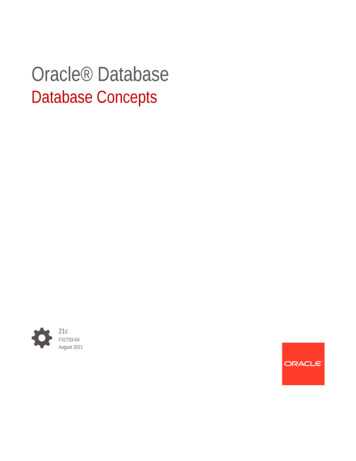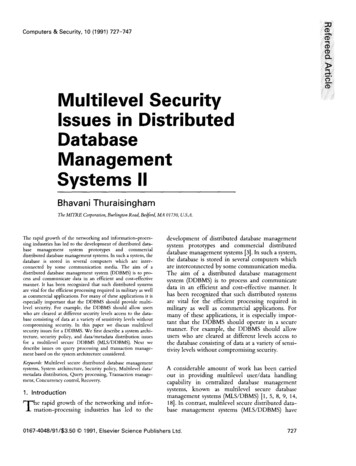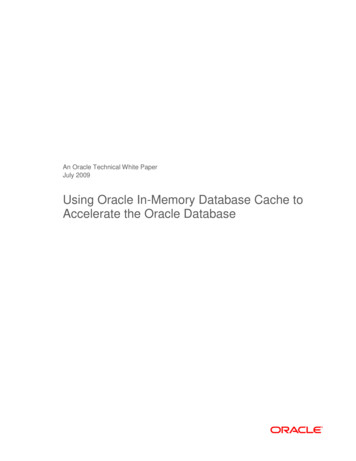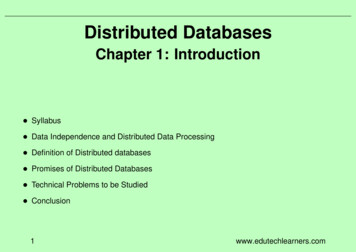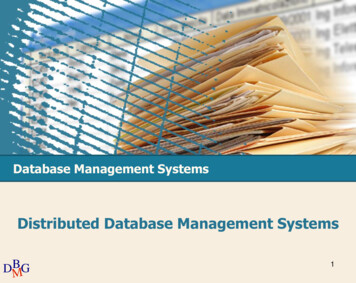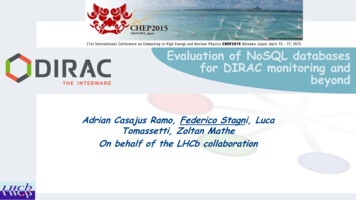
Transcription
Advanced Database Group Project Distributed Database with SQL ServerHung Chang, Qingyi ZhuErasmus Mundus IT4BI1. Introduction1.1 MotivationDistributed database is vague for us. How to differentiate the database system isthe distributed database? Do they have the degree of distribution? For such a case inTaiwan is the distributed database because of different locations and the query ability?First, Five SQL Server databases located in five different flower markets andtransmitted data in CSV file format to one data warehouse as figure 1.1. Thetransaction data generated by Auction Clock won’t update after 12 A.M owing totransactions in all markets finished before 12 A.M. Second, the market managers andthe flower growers query the data originally in different location through OLAP.Figure 1.1 : Location of Five Databases and Auction Clocks [1]In this case, five databases didn’t connect together directly through the internetdue to the privacy issues. They only uploaded their data through internet. For example,the SQL Server in Kaohsiung city couldn't query the database in Taipei city. Theycould only query with OLAP. Therefore, are they distributed database? What level ofdistribution did this case have? Could they distribute better?1
1.2 Research ProcessWe studied the distributed database from both theory and practical. First, readingthe book "Principles of Distributed Database System"[2] to know the concepts anddefinitions, and then searching the keywords in MSDN[3] to understand the distributeddatabase with SQL Server. However, many different terminologies between SQLServer and the book cause the difficulties. The reasons come from a lot of distributeddatabase product share the market based on figure 1.3 [4]. A note of distributed SQLServer [5] exits but without replication section and terminologies matching.This article describes the different levels of distributed database to solve ourconfusion, and shows the ability of distributed SQL Server. Meanwhile, discussing theterminologies in "Principles of Distributed Database System" and SQL Server is alsothe article main task.Follows are the structure of the article. Section 2 reviews the transparency.Section 3 describes the way SQL Server becomes distributed. Section 4 shows thedistributed transaction with SQL Server. Section 5 demonstrates fragmentation withSQL Server. Section 6 demonstrates the replication with SQL Server. Section 7describes the difficulties when setting up the distributed SQL Server. Section 8 is theconclusion.Figure 1.3 : Distributed Database Software[4]2
2. Transparency ManagementTransparent Management means how good the database distributed. With a fullytransparent DBMS the developer needs not to pay much attention to deal with the kindof query which needs a distributed, fragmented and replicated database. Thetransparency services can be provided at three distinct layers. The first layer at whichtransparency can be provided is the access level. It provides transparent access to dataresources. The second layer at which transparency can be provided is the operatingsystem level. State-of-the-art operating systems provide some level of transparency tosystem users. The third layer at which transparency can be provided is the DBMS level.It provides translations from the operating system to the higher-level user interface. Ahierarchy of these transparencies is shown in Figure 2.1. This suggests SQL Serveronly can provide transparency of replication, fragmentation and language. TheSection 4 discusses the Language Transparency.Replication Transparency means the existence of replicas and the manner ofdistributing the replicas across the network is transparent. The user applications need todetermine how many copies to have and where to put these replicas. It will have aneffect on the performance, reliability and availability of user applications.Fragmentation Transparency means the fragmentation of database is transparent.Since a global query is divided into several fragment queries, the query processingbecomes the fundamental issue of dealing with fragmentation transparency.Considering of the ease of use and the difficulty and the cost of providing high levelsof transparency, we need to decide the level of transparency.Figure 2.1 : Layers of Transparency3
3. Linked Servers and Distributed DatabaseThe book describes distributed database is different databases running ondifferent servers. For instance, Figure 2.1 is not a distributed database because theDBMS only at one site (server). Figure 2.2 is a distributed database because theDBMSs are running on different sites (servers).Figure 2.1 : Not Distributed Database[2]Figure 2.2 : Distributed Database[2]MSDN names distributed SQL Server as Linked Server. The distributed query onSQL Server explains why Linked Server has the same definition as the book in thenext section. Here firstly showing the way to build the distributed database on SQLServer. Two methods which are the Transact-SQL and the configuration of SQLmanagement studio can generate Linked Server. For example, three databases on4
different servers link together using a Transact-SQL.Server 1 : TainanServer 2: TaipeiServer 3: TaichungEXEC sp addlinkedserver@server ' Tainan',@provider 'SQLNCLI',@datasrc 'TinanDB'EXEC sp addlinkedserver@server ' Taipei',@provider 'SQLNCLI',@datasrc 'TaipeiDB'EXEC sp addlinkedserver@server ' Taichung',@provider 'SQLNCLI',@datasrc 'TaichungDB'Three store procedures created the linked servers at each three servers.sp addlinkedserver is the name of the procedure. @server is the name of the linkedserver. @provider is the OLE DB provider. If @provider 'MSDAORA', thedistributed database is heterogamous due to this is an oracle provider. If all @provider 'SQLNCLI' , it is homogenous distributed database. @datasrc is the data source.5
4. Language Transparency and Distributed QueryTransparency presents the level of database distribution. Liked Server is at theLanguage Transparency level because when querying the tables it must know the nameof the partitions, tables and servers.In SQL Server environment, after creating the linked servers, can query the tablesin different servers. Assume the query executes at Tainan city. The Transact-SQL is asfollows.SELECT * FROMflowerDB.dbo.supplierUNION ALLSELECT * FROMTaipei.flowerDB.dbo. supplierUNION ALLSELECT * FROMTaichung. flowerDB.dbo. supplierThis example describes the tables needed to query are at the server in Taipei cityand server in Taichung city separately. The result returns all the suppliers in thosecities.6
4. MS DTC and Distributed TransactionSQL Server database engine and MS DTC(Microsoft Distributed TransactionCoordinator) controls the distributed transactions in SQL Server. A transact-SQLstatement starts a distributed transaction when adding the following statement at thebeginning.BEGIN DISTRIBUTED TRANSACTIONThen, the instance of the SQL Server executes the Transact-SQL will become thecoordinator in this transaction, and perform local or remote distributed queries throwMS DTC. MS DTC enlists all linked servers involved in this transaction as theparticipants. Next, the controlling servers apply the Two Phase Protocol between thelinked servers to manage the ROLLBACK and COMMIT. The Two Phase Protocoloperated as figure 4.1[2]. At first, the local SQL server asks the linked server forpreparing to commit. If the participant is ready, it will return Yes else NO. Then thecoordinator knows the status of participant is YES and starts to commit. When theparticipant have committed, it sends the message to the participant and the participantwrites end, and the whole process ends. Conversely, the rollback case also shows infigure 4.1.Figure 4.1 : Two Phase Protocol[2]7
5. Distributed Partitioned Views and HorizontalFragmentationSQL Server uses Distributed Partitioned Views as the horizontal fragmentation.The fragmentation means a table is divided into many tables. One is verticalfragmentation and it separates the columns of a table into two tables which have part ofcolumns in the original table. The other is horizontal fragmentation and it separates therow of a table into two tables which have part of rows in the original table. For example,a flower table has 4 columns and 4 rows as follows. The horizontal fragmentation is asTable 5.2 and Table 5.3 based on the location.Table 5.1 : A Fragmentation ExampleFlowerNamePrice 60Medium 200Chrysanthemum 50Medium 10Table 5.1 : Horizontal Fragmentation ble 5.2 : Horizontal Fragmentation rysanthemum50Medium10SQL Server provides First, executing transact-SQL in one local database and thetransact-SQL as follows. through Distributed Partitioned Views and CHECKconstraints. Here is an example. Assume that Tainan stores the flower data fromFlowerID 1-100, and Tapei stores the flower data from FlowerID 101-200, andTaichung stores the flower data from FlowerID 201-300.First, create the Distributed Partitioned Views by executing the transact-SQL ineach local database as follows.8
-- On Tainan ServerCREATE VIEW AllFlower ASSELECT * FROMflowerDB.dbo.flowerUNION ALLSELECT * FROMTaipei. flowerDB.dbo.flower 200UNION ALLSELECT * FROMTaichung. flowerDB.dbo.flower 300-- On Taipei ServerCREATE VIEW AllFlower ASSELECT * FROMTainan. flowerDB.dbo.flower 100UNION ALLSELECT * FROMflowerDB.dbo.flower 200UNION ALLSELECT * FROMTaichung.flowerDB.dbo.flower 300-- On Taichung ServerCREATE VIEW AllFlower ASSELECT * FROMTainan. flowerDB.dbo.flower 100UNION ALLSELECT * FROMTaipei.flowerDB.dbo.flower 200UNION ALLSELECT * FROMDBteacher.dbo.Teacher 3009
The CHECK constraints ensures the rules in the partition tables as followingtransact-SQL-- On Server1:CREATE TABLE dbo.flower 100(ID INTEGER PRIMARY KEYCHECK (ID BETWEEN 1 AND 100)-- On Server2:CREATE TABLE dbo.flower 200(ID INTEGER PRIMARY KEYCHECK (ID BETWEEN 101 AND 200)-- On Server3:CREATE TABLE dbo.flower 300(ID INTEGER PRIMARY KEYCHECK (ID BETWEEN 201 AND 300),The CHECK constraints help the optimization of distributed query to achieve thesmallest data delivery between linked servers to minimize the cost of distributed query.Therefore, SQL Server refers the CHECK constraints to better execute the distributedquery. For example, we want to know which flower ID is between 51 and 103. The SQLServer will not issue a query to server 3 according to the CHECK Constraints, onlyquery server1 and server2.SELECT *FROM AllFlowerWHERE ID BETWEEN 100 AND 20010
6. Replication6.1 TheoryReplication improves the reliability of distributed database explaining theimportance of it. Replication has different degree. For example, the database is fullyreplicated and stores the replicated databases in different sites, or the database ispartially replicated and stores the replicated partitions in different sites. This showsthree replication problems. First, duplication of data means choosing one of severalcopies to retrieve, and update each copy. Second, problem occurs when some sites orsome communication links fail while executing an update. The system must ensure thatit can recover from the failure. The third problem is about the synchronization. Whenexecuting the query, the system need to get data from different sites, so the difficulty isto satisfy the synchronization of transactions on multiple sites. Some protocols aredesigned to ensure the consistency of the copies of database. These protocols can beeager or lazy. The eager means that all the updates must be applied to all the copiesbefore transaction completes. The lazy means that the updates of other copies can bedone after the transaction of one copy is completed.6.2 Replication with SQL ServerSQL Server calls the problems as the autonomy and latency, and provides thesolution with three roles (as figure 6.1). An on-line bookstore illustrates how the SQLServer replication works. The boss of bookstore (publisher) can decide the books(article) to sell, but the books (article) must put in a shelf (publication) which theclient (Subscriber) can choose from, and the boss asks express delivery (distributors)for sending the books to the client periodically. In fact, SQL Server Replication Agentcontrols the mechanism.Publisher Maintain thepublication and articleDistributer Transfer thepublication andarticleSubscriber Receive thepublication andarticleFigure 6.1 : The relation Between Three roles in SQL Server Replication11
SQL Server provides three types of replication for use in distributed applications:Transactional replication, Merge replication, Snapshot replication as figure 6.2. Thedifference is the autonomy and latency issues.The Snapshot replication distributes data at a specific moment in time withoutmonitoring the updates of data. This type is better if data doesn’t change frequently oris few. The Transactional replication responds each time of the change, instead of onlyrespond to the final change while several changes happen. It begins with a publicationof database objects and a snapshot of data. After creating the initial snapshot, datachanges deliver to subscriber immediately when there are some data changes inpublisher. The order of data changes is also the same to guarantee the transactionalconsistency within a publication. This type is better to deal with the synchronizationproblem. Besides, it assures low latency between the time changes made at thePublisher and the changes arrived at the Subscriber. The Merge replication uses triggersto track data changes in the Publisher and Subscribers. When subscriber connects to thenetwork, it will synchronize with the publisher. If more than one Subscriber whichupdate the same data at different time, and then spread the changes to server and othersubscribers, it’s better to use merge replication. Sometimes conflicts exist, and Mergereplication deal with them in different ways.The difference between Merge replication and Transactional replication is thatMerge replication doesn’t synchronize each change. So, though the data in Subscriberhas changed several times, the publisher only reflects the final change.Figure 6.2 Three Main Method for Replication12
7. Difficulties of Setting Distributed SQL ServerThis section focuses on the trouble-shooting of setting distributed SQL Server.Two virtual machines simulate the distributed database scenario. It is the case becausewithout connecting to the internet, the SQL Server can't connect to the other. If theSQL server on two virtual machines can connect each other without internet, it justrepresents a server with two databases.Figure 7.1 : Error Massage when without internet connection.7.1 Fail to Build Linked ServerSometimes the servers’ links fail due to the network problem. To build linkedservers, Firewall, SQL Server Browser, and SQL Server Network Configuration(TCP/IP, Named Pipes) in SQL Server Configuration must be suitable configured.Figure 7.2 : SQL Server Configuration Manager13
If the setting is suitable configured, browsing the network servers inManagement Studio can see the database on the other sever. The example runs onVMware to represent two different servers.Figure 7.3 : Browsing the Database on the Other ServerTyping the Transact-SQL can add linked server successfully if the above internetsetting of SQL Server has been done. The bottom left window shows Linked serverhas created, and the bottom window shows the distributed query executes successful.Figure 7.4 : Linked Server14
7.2 Fail to Begin Distribute TransactionTo begin distributed transaction, it is still not enough. The following errormassage shows the MS DTC is not activated. To start the MS DTC, Open START SETTINGS CONTROL PANEL ADMINISTRATIVE TOOLS SERVICES, andstart the service called 'Distributed Transaction Coordinator'.Figure 7.5 : Error of MS DTCFigure 7.6 : MS DTC activates15
8. ConclusionThe terminologies between SQL Server and the books are very confusing, forinstance, Linked Server, Publisher and Subscriber. This implies originally eachDBMS software doesn’t provide distributed database, they add the features based onthe Client/Server architecture. This also suggests no pure distributed databasesoftware exits.On the other hand, SQL Server has the ability to implement a lot of promises ofdistributed database, such as distributed query, distributed transaction, fragmentationand replication, which can also set-up with Management Studio. The linked serverprovides the basic structure for distributed database. Based on linked server, theinstances on SQL Server can execute distributed query, perform distributedtransaction through MS DTC, and horizontal fragmentation, but the replication shouldset in the other way. Although the different terminologies between the book and SQLServer confuse a lot, it still provides the excellent way to implement the distributeddatabase.9. Reference[1][2][3][4][5]G. R. Liang, "Incentive Driven Supply Chain," 2009.M. Tamer èOzsu and P. Valduriez, Principles of Distributed Database Systems:Springer, 2011.Microsoft. (2013). MSDN. Available: http://msdn.microsoft.com/en-US/J. A. Hoffer, R. Venkataraman, and H. Topi, Modern Database Management,11/E: Prentice Hall, legati/16
Figure 2.1 : Not Distributed Database[2] Figure 2.2 : Distributed Database[2] MSDN names distributed SQL Server as Linked Server. The distributed query on SQL Server explains why Linked Server has the same definition as the book in the next section. Here firstly showing the way to build the distributed database on SQL Server.

